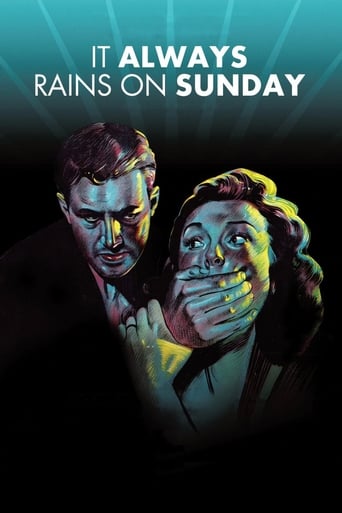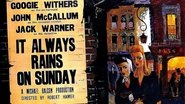roy-78517
I watched this film when it was first released at my local cinema in Hackney. It was the first film that I had ever seen which showed an East End which I could recognise as the one I knew. All the characters were recognisable and true to life. One caveat thought, we see the husband having a hipbath in his kitchen (true to life), but I did wonder where all the hot water came from.certainly not from the tap!, Although I grew up in Hackney, within walking distance, all my immediate family came from there and, as I discovered later,many generations earlier too. Very much a Jewish East End too. This sounds like a cliche, but most of my best school friends were Jewish boys (NEVER jewboys which was pejorative ).
It was a delight to see it again, I must search around to find a good copy on DVD.
I lovely film which took me back seventy years or more to my boyhood.
Alex da Silva
John McCallum (Tommy) escapes from Dartmoor prison and seeks out his ex-girlfriend Googie Withers (Rose) for food and clothing to help him on his way. Googie is now married to Edward Chapman (George) and lives with his 2 daughters and a son of their own. I think? The son seems a bit old but I think that's the relationship as he refers to Googie as 'mum'. We get involved in their claustrophobic life in their community where everyone seems to know each other. It's the East End of London and everyone is 'salt of the earth'. You get spivs, gangsters, family life and detective Jack Warner (Fothergill) on the trail of McCallum. Googie and McCallum do get together in real life but things are different in this film.The main plot follows the escaped convict storyline but this film is also about family life with characters having their own agendas. Which room is the best room in the house to hide an escaped criminal? You won't believe where Googie directs her ex not only to hideout but also to have a kip! We see McCallum's true feelings towards Googie unravel in the later stages of the film and there is quite an intense final scene as he makes a break for it. I watched the film on a Sunday. And it was raining.
vespatian75
Wonderful little film from post WW2 Britain. After the World War Europe and America were exhausted, It became the era of the "little film". In the US there was "film noir", in Italy "neo realism", France and Britain shared in the movement. Beyond the crime pictures there were the slice of life films that focused on the lives and problems of ordinary people. "It Always Rains on Sunday" combines both themes. There is the criminal element and there is the focus on day to day living in a mixed industrial/ residential neighborhood, the East End of London, reminiscent of neighborhoods in post war New York. It manages to tell a story involving inter related lives. Every character is treated sympathetically but the film is by no means sentimental. Even the ostensible villain, Tony Snow becomes a sympathetic character. Amoral, but ultimately more sinned against than sinning, only at the end do we see the depths of his desperation. We come to understand and empathize with all the characters as we view them trying to deal with problems of existence in a tough unforgiving world. The two leads in particular give wonderful performances. that can be overwhelming. A must see for film lovers.
trpuk1968
Film Noir defies definition, plenty disagree whether its a movement, genre, style. Perhaps its more usefully conceived as a sensibility, a world view, an attitude. In which case the words pessimism, determinism ie characters lacking choice their lives are predetermined, doom, gloom, the past coming back to affect the present all spring to mind. Its possible to see a cycle of films with remarkably consistent features in terms of visual style emerging in U.S primarily and to a lesser extent the U.K and France in the forties and fifties. While most noir films have a male as the central protagonist, a male who is invariably weak and flawed, a number of these films, such as Mildred Pierce, have a female protagonist. Noir manifested itself differently in Britain, combining with elements of what was to become known as kitchen sink or social realism and frequently concerned with social class.This film uses the claustrophobic interiors of the terraced house to great effect. The noir style of long shadows, oblique angles, becomes more evident in the final climax, not really needed early on since the interiors work effectively without lighting effects. Melancholia drips through this like the rain of the title, Googie Withers is terrific, her face a mask of dreams, desires pushed away, disappointment etched over her features through her hard make up. How different she is in appearance to the femmes fatales of the U.S movies, bustling round the kitchen in her pinafore, then later on the almost military smartness of her utility dress when she attends Tommy. As a character shes every bit as strong however as her American counterparts. Like Mildred Pierce, she's strong in a domestic setting, when the usual convention for women in noir is to take them out of the domestic, placing them typically as nightclub singers or gangsters molls. In details I ll acknowledge this is on occasions cheesy and dated. Scratch at the surface however and its a fascinating exploration of the social tensions emerging after World War Two. How were people to adjust to life in peacetime? Were they able to return to the rigidly prescribed roles they d had prior to the war? Ealing studios produced a number of films which now can be seen to share many affinities with American Film Noir, this is one of the most interesting and rewarding.





